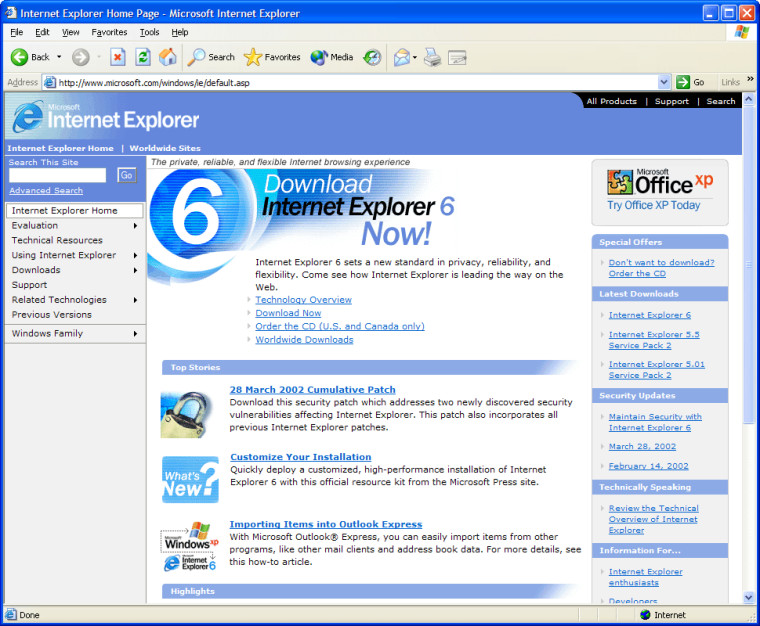
Earlier this month, we talked about the launch of Microsoft's first web browser, Internet Explorer 1.0, back in 1995. It was a pretty bare-bones browser, but Microsoft quickly updated it with a 2.0 version later that year, followed by 3.0 in 1996, 4.0 in 1997, and 5.0 in 1999.
On August 24, 2001, 22 years ago this week, Microsoft Internet Explorer 6.0 was released, a couple of months before the company's next consumer OS, Windows XP, was launched. The browser, which we will refer to as IE6 from now on, quickly dominated the market with a share as high as 90 percent at one point in 2004.
However, the release of IE6 might have been the start of a major turning point in Microsoft's command of the browser market. That's because of three developments, all of which led into each other. The first was that Microsoft basically decided, after six major releases of IE, to take a step back and not try to develop and release a major feature update to IE6 as quickly as previous IE versions has been updated in the past.
That lack of active development led to the discovery of a number of serious security flaws in IE6. As reported by ZDNet at the time, in 2004 security researchers found lots of issues in the browser. These flaws were being used by hackers to infect the PCs of IE6 users by them just visiting infected websites. The security issues let IE6 to download malware directly to PCs via those sites.
Those flaws in Microsoft's web browser got so bad that, in June 2004, the US government had to issue an advisory asking PC owners not to use IE6 without certain precautions. An archived post from the US Computer Emergency Readiness Team (US-CERT) at Carnegie Mellon University describes the issue:
Microsoft Internet Explorer (IE) does not adequately validate the security context of a frame that has been redirected by a web server. An attacker could exploit this vulnerability to evaluate script in different security domains. By causing script to be evaluated in the Local Machine Zone, the attacker could execute arbitrary code with the privileges of the user running IE.
Microsoft did issue patches to try to correct these issues, but US-CERT also advised IE6 users to disable Active scripting and ActiveX controls in the browser or just use another browser completely.
That piece of advice led to the third development, which was the release of Mozilla's Firefox browser. Launched in November 2004, the free and open-source browser had lots of new features and fewer security issues compared to IE6, and it quickly became a popular alternative.
As a result, Microsoft never dominated the web browser market share again as it did at the peak of IE6 in 2004. That was especially true after the launch of Google's Chrome browser which launched a few years later in 2008.

Microsoft finally released Internet Explorer 7.0 in October 2006, over five years after the release of IE6. Yet, Microsoft's buggy browser still was used by lots of people around the world several years later. In 2011, Microsoft launched a marketing campaign called IE6 Countdown, urging users to stop using the old web browser 10 years after it launched. That campaign eventually succeeded in that goal.
Of course, now the IE brand itself has been eliminated completely as Microsoft moved on with its Edge browser. Updates to browsers, and indeed major software products as a whole, have also evolved beyond what they were in 2004, as new features and bug fixes are released at a far more rapid and regular pace than ever, thanks in part to the rise of fast broadband internet speeds.
Microsoft's complacency with the launch of IE6 22 years ago was a big reason why rivals were able to beat the company in the browser wars, and that continues to this day. While Firefox is not as popular as it once was, Chrome and Apple's Safari both top Microsoft Edge in use, according to StatCounter's most recent numbers.
- aum
-

 1
1



3175x175(CURRENT).thumb.jpg.b05acc060982b36f5891ba728e6d953c.jpg)
Recommended Comments
There are no comments to display.
Join the conversation
You can post now and register later. If you have an account, sign in now to post with your account.
Note: Your post will require moderator approval before it will be visible.